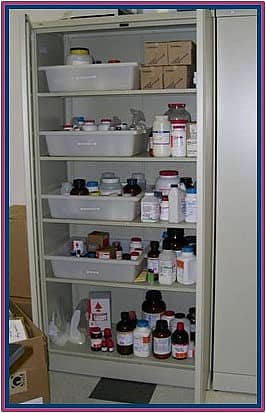Chemical inventories should be reviewed and updated at least annually, and the end of the year is a great time to update a facility’s inventory. It’s an opportunity to confirm what’s in use and storage, and can result in disposing expired or unwanted chemicals, so there’s more storage room in the new year.
In New York City, there is one particular regulatory reason to conduct annual inventories at the end of the year: NYC Department of Environmental Protection’s (DEP) Community Right-to-Know (RTK) Program. The DEP oversees the storage and use of hazardous substances that pose a threat to public health and the environment, and facilities must report chemicals that exceed threshold reporting quantities (TRQ) of listed hazardous substances that were present in a facility within the previous calendar year. The TRQs in the NYC DEP’s hazardous substances list are lower than the Environmental Protection Agency’s (EPA) Emergency Planning and Community Right-to-Know Act (EPCRA) reportable quantities and include common laboratory chemicals that do not require EPCRA reporting. The NYC RTK report is due on March 1 of each year.
There are additional regulatory reasons to conduct annual chemical inventories. Chapter 8 of NFPA 45 states that “chemical inventories in each laboratory unit shall be maintained within the maximum allowable quantities specified in the applicable fire code or building code”. The NYC Fire Code implements the 2015 edition of NFPA 45 with modifications. Section 5006 of the Fire Code also enforces laboratory unit quantity limitations. As research develops and companies grow, the scale of work and the quantity of chemicals that are stored tend to increase, so it’s important to verify that storage has not exceeded maximum allowable quantities (MAQ) on a facility’s Laboratory Unit Permit and specified in the NYC Fire Code.
In addition, certain classes of chemicals have lower MAQs when they’re used and stored in research and development laboratories. For example, the NYC Building and Fire Codes allow for the storage of up to 10 pounds of highly toxic chemicals in a facility. However, if that facility is a laboratory, Chapter 50 of the NYC Fire Code states that the storage limit for highly toxic chemicals within a laboratory unit is 5 pounds. Some common laboratory chemicals including sodium azide and cyanides are classified as highly toxic, so if your facility uses either of these chemicals (or any others classified as highly toxic), it’s important to update inventories to confirm that quantities are below MAQs.
NFPA 45 also states that proper chemical inventory management involves identifying materials that are time sensitive, and determining appropriate inspection methods to determine when the time sensitive material is no longer safe to use or store. The NYC Fire Code modifies this statement to emphasize that inventory management should include the identification of chemicals that can become hazardous during prolonged storage.
For additional information on completing a chemical inventory at your facility to meet NYC permitting requirements, or for assistance in determining end-of-year inventory and permitting requirements of other state and local regulations, please email us at [email protected].
This blog was written by Rae Moore, Safety Partners’ Senior Quality, Research, and Training Specialist.


